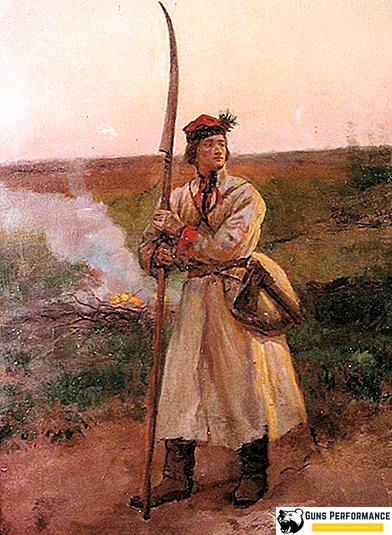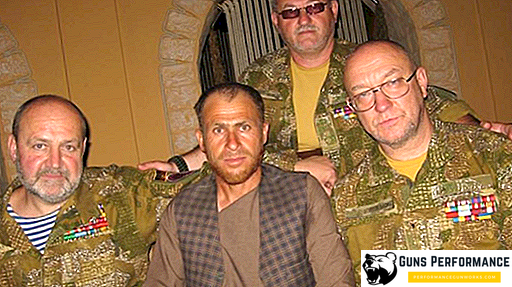
The fighting spit is a very interesting weapon, which is a peasant agricultural tool converted for battle. In a modernized form, the battle scythe is a real melee weapon, similar to the Japanese Naginatus.
The simplest version of the fighting spit is a shaft, on which a simple scythe, or a specially forged knife, is set. Sometimes, special swords with double-edged sharpening were made for a fighting spit. Most often, the usual braid just unbend at the junction. The junction of the blade to the pole for reliability, iron or riveted. The shaft in the upper third was bound with iron or wrapped with wire, which prevented it from being cut.
The history of the appearance of fighting spit

When the usual braid appeared, it is not exactly known. According to some sources, it can be concluded that it was known in the times of the early Middle Ages. The use of combat braids as weapons was recorded in the 14th and 16th centuries, although, most likely, it was used even earlier. Life at that time was harsh, and if every peasant had an ax in the household, then only hunters had spears. But the spit could quickly become a weapon operating on the principle of a wide slashing spear.
After a simple manipulation of the extension of the compound, the braid could already be used as a melee weapon, which made it possible to keep the enemy at a distance. Especially effective this weapon proved to be in the battles against the riders. There was even a special style of combat, when one peasant with the usual oblique clipped the legs of a horse, and the second quickly killed the rider falling from his horse.
The first written references to the use of war braids can be found in the annals of the 14th century. It was these scythes that were used by Swiss infantry, who were recruited from the peasants of the cantons of Uri, Unterwalden and Schwyz. In the battle against the Austrian knights, the battle scythe proved to be a real weapon of death.
Combat oblique enjoyed during the "Hussite" wars and during the "Great Peasant War" in 1525. It may seem that the use of combat braids is due to the inaccessibility of other weapons, but this is far from the case. Against the knightly cavalry, it was fighting spit that could compete on equal footing with peaks. Since it was unusual for yesterday’s peasants to wield a spear, they preferred to use the fighting scythe with which they had known since childhood.
In the battle with the knightly cavalry, the battle scythes were used as follows:
- If the scythe was with a hook, then they could pull the knight off his horse;
- Combat oblique was very convenient to cut the tendons of the horses;
- A scythe could be cut off the head;
- Forward fighting spit used as spikes.
Although the battle scythe was a rather heavy and bulky weapon, the peasants accustomed to it were chopped down with extraordinary dexterity.
Close relatives of the spit

Among the medieval weapons, which looked like a battle scythe, stood out of the glaive and cuza. Glaive was a knife-shaped tip that was attached to a long shaft with a sleeve. This weapon could be used both for injections and for cutting.
At the Polish court, the king’s bodyguards used another version of the glafia, called the cossack. The main difference between the cuz and the glafu was that it was designed to use powerful chopping blows that could cut through the armor. In the 16th century, the popularity of the body increased so much that even the Swiss mercenaries who served at the court of the French king armed themselves with the body.

Scythe in Eastern Europe
In the history of Eastern Europe, the appearance of a battle scythe is closely connected with the Zaporozhye Cossacks. It was they who widely used the fighting spit, since many of them were yesterday's peasants. Naturally, professional Zaporozhye Cossacks despised the battle scythe, but for beginners this weapon was familiar from childhood.
The 17-18 centuries became the bloodiest in the history of the Ukrainian, Polish and Russian peasantry. Throughout Eastern Europe, peasant liberation wars and riots raged. Since the peasants had no weapons, they had to manage with household tools, such as axes, scythes, and pitchforks. It was the fighting spit that proved to be an excellent defensive weapon against cavalry.
In the history of Eastern Europe, the fighting spits were most widely used during the uprisings of Razin and Pugachev. Entire groups of peasants were armed with these simple but effective weapons.
It often happened that former peasants, after several successful battles, acquired real military weapons, throwing out their fighting braids. Having dressed as Cossacks, former peasants did not even want to take braids in their hands. Nevertheless, there are cases when the “peasant” atamans forbade their personal guards to throw out the fighting spit. Although they were dressed like real Cossacks and had a full set of weapons, the braids stuck behind them. This measure was used to attract as many peasants as possible to their side, showing them that the brave Cossacks had recently been the same farmers with braids.
Battle Scythe in Poland

In Poland, serfs with braids formed special detachments of the so-called "cosiners". These units participated in the days of the "Swedish Flood", which was in the years 1655-1660. Cosiniers in battles used such tactics, which allowed the most effective combat scythe. They became the second or third row of troops, just behind the arrows.
The fighting oblique on the long arm could prick and hack the enemy. This was the advantage of the spit over the peak, which only allowed to prick. In those years, works were drawn up on the tactics of career and pikeners. The battle scythe in battle was given the role of supporting the warriors with spikes, since the spit had a wide amplitude of impact.
Although braids were most often used in group battles, there are documents from that era showing the incredible effectiveness of these weapons. The average infantryman, armed with a rifle (with a bayonet), had no chance in close combat with the carrier.
The professional armies of those years with undisguised contempt belonged to the crowds of peasants with scythes, for which many paid with their lives. Even the generals were surprised at the fighting abilities of the peasants, who were armed with fighting braids.
The wounds inflicted by the war scythe
The wounds inflicted by the war scythe were a terrible sight. Due to the thin blades and excellent sharpening, the battle scythe inflicted long and deep cut wounds. The enemy, who received such a wound, often died from a huge loss of blood.
Naturally, the blade with such parameters had one major drawback. The spit was ineffective against a warrior in armor. These design flaws were attempted to be minimized by training to strike blows with a military oblique on areas of the body not protected by armor. In this case, there were blows to the face, hands and feet.
The role of the battle scythe during the Polish uprising of 1863
During the Polish (or, as it is also called, the January) uprising, which lasted 16 months in a row (from January 1863 to April 1864), and whose goal was to restore the Commonwealth in 1772, General Miroslavsky, the proclaimed dictator of the uprising, developed a new tactic for the cosiners. From the recollections of an eyewitness, Lieutenant Colonel von Erlach, who wrote the work "Guerrilla War in Poland in 1863", it can be concluded that the detachment of trainers terrified the enemy even during the march, as the sound of braids, inadvertently touching, made not the most favorable impression on the enemy.
Experts argue that the latest use of combat spit dates from the 20th century and is associated with the bloody uprising of 1921 in Upper Silesia against the German authorities in the Weimar Republic. In addition, the military spit was used as a weapon in 1939 to repel the German offensive in northern Poland in the city of Gdynia.
The private museum of the history of weapons in Zaporozhye offers to the attention of visitors an exposition of combat braids mainly from the history of Poland of the 18-19 centuries. Taking into account the inscriptions in German on the spit stahl (from it. - "steel") or images of the German cross, we can assume that they were still made in Germany. Some experts suggest that these exhibits were directly used by Polish cosineers during the uprisings of 1831 and 1863-1864.

The popularity of the battle scythe as a weapon of the peasant infantry over the course of more than one decade is due, first and foremost, to its simplicity of construction and low material costs. Anyone could afford such a rather formidable weapon, because for this it was necessary to simply change the fastening of the spit on the pole.












